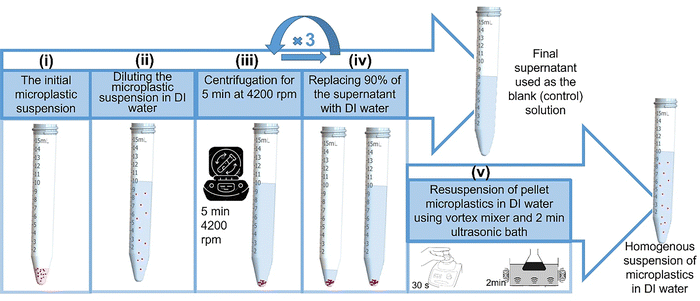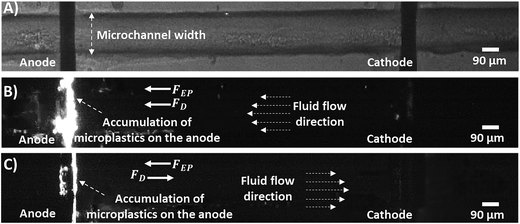Considering the increasing concern about the pervasiveness of small microplastics (<20 μm), technologies should invest on detection of particles in these size ranges. Finding the sources of pollution and stopping the spread of microplastics into the environment also need moving toward the development of portable sensors for on-site detection of microplastics.
Here, we proposed a simple low-cost microfluidic device to simultaneously extract and detect microplastics using electrophoretic force and electrical resistance measurement between two microwires in a straight microchannel.
We developed a simple wide PDMS channel equipped with two copper microwire electrodes, orthogonal to the flow direction and connected to a DC sourcemeter, for electrical resistance-based sensing of polystyrene microplastics in water. Electrical resistance between the two microwires was associated with microplastics’ size and concentration, following their electrophoretic accumulation around the positive electrode. A positive correlation was found between microplastic concentration and reduction in the normalized resistance. Reducing the flow rate strengthened the extraction and detection of larger microplastics. In the future, the sensor will be tested for other types of microplastics in real samples and can be integrated into a handheld device for low cost and on-site microplastic detection.




Publications
Haider Warraich, Alireza Zabihihesari, Shooka Karimpour, Pouya Rezai
Microchimica Acta, vol. 192(8), 2025, p. 476
Shapour Jafargholinejad, Basit Ilyas, Alireza Zabihihesari, Razieh Salahandish, Stephanie Gora, Pouya Rezai
Under review , 2025
Alireza Zabihihesari, Arezoo Khalili, Mohammad-Javad Farshchi-Heydari, A. Eilaghi, P. Rezai
New Journal of Chemistry, vol. 47(19), 2023, pp. 9050-9060
Haider Warraich, Alireza Zabihihesari, Shooka Karimpour, Pouya Rezai
The 27th International Conference on Miniaturized Systems for Chemistry and Life Sciences (µTAS 2023), October 15 – 19, 2023, Katowice, Poland, 2023
Haider Warraich, Alireza Zabihihesari, Shooka Karimpour, Pouya Rezai
American Water Works Association (AWWA) Annual Conference & Exposition (ACE), June 11-14, 2023, Toronto, Canada, 2023
A low-cost microfluidic sensor for detection of microplastics in salty water
Haider Warraich, Alireza Zabihihesari, Shooka Karimpour, Pouya Rezai
3rd Conference on Micro Flow and Interfacial Phenomena (µFIP), June 18-21, 2023, Evanston, Illinois, US, 2023
A Low-Cost Micro-Electro-Fluidic Device for Enrichment and Detection of Microplastics in Water
Alireza Zabihihesari, Arezoo Khalili, Pouya Rezai
Micro and Nanotechnology in Medicine (MNM) conference, the IEEE Engineering in Medicine & Biology Society (EMBS), December 5-9, 2022, Disney Aulani, Hawaii, US, 2022